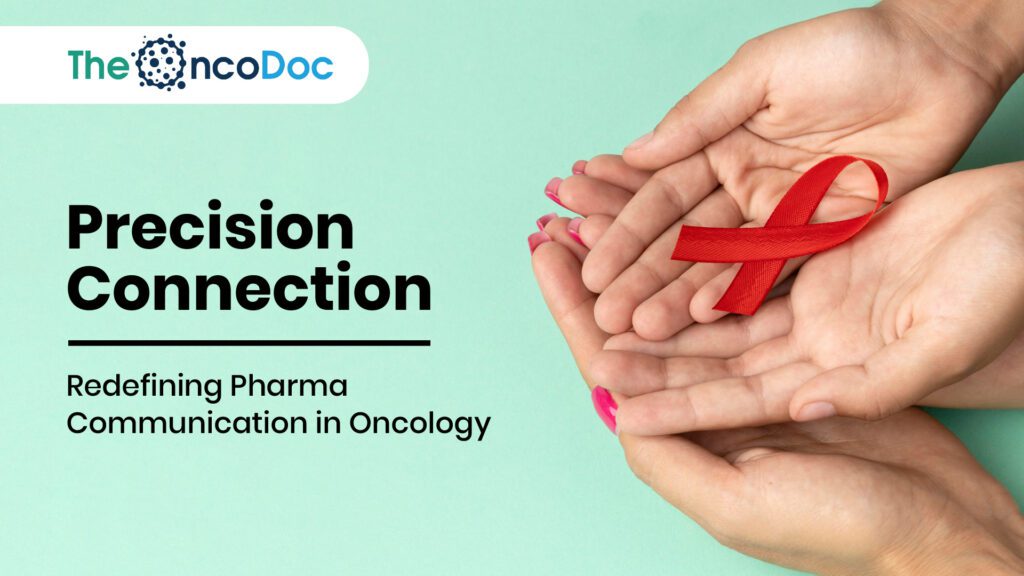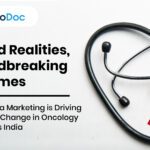Introduction: From Push to Precision in Oncology Marketing
By 2025, the oncology landscape is increasingly defined by precision medicine, patient-centricity, and technology integration. While therapies become more personalized and clinical decisions more complex, pharma marketing to oncologists must evolve just as rapidly. Traditionally rooted in product promotion, pharma communication is now being reshaped by digital engagement, behavioral targeting, and localized insights.
This article explores how a precision communication approach is redefining how pharma engages oncologists. It blends AI-driven insights with ethical storytelling, local relevance, and a deep respect for the modern oncologist’s clinical reality. With over 2000 words of strategic insights, use cases, and updated charts, we examine the new pillars of effective pharma-oncology partnerships.
1. Listening First: Why Pharma Needs to Relearn Oncologist Pain Points
Effective marketing starts with listening. Oncologists today are not looking for more promotional messaging; they seek clinically relevant support. Over the past decade, the digital health ecosystem has enabled new touchpoints, but many oncologists still report being overwhelmed by redundant or irrelevant content.
A survey conducted in early 2025 identified the top challenges oncologists face in pharma communication:
These numbers highlight the demand for more personalized, context-aware, and clinically helpful content. Pharma companies must transition from a “push” model to a value-adding partnership-one rooted in solving real problems rather than promoting products.
2. The Rise of Clinical Utility Over Brand Recall
In today’s clinical environment, oncologists are inundated with therapeutic options, especially in areas like immunotherapy, targeted drugs, and biosimilars. What cuts through the noise is not flashy branding, but content that aids in real-world clinical decision-making.
This includes: – Quick-reference guides comparing drug efficacy and safety – Visual algorithms based on staging or biomarker status – Mobile tools for calculating dosage or treatment cost
Pharma brands that provide such resources are not just remembered-they’re used. For instance, Roche’s introduction of their ‘myPathway’ clinical decision tool-a real-time companion app that helps oncologists match patients with personalized therapies-has seen significant adoption across top-tier oncology centers. The platform provides interactive treatment algorithms and is updated with the latest NCCN guidelines, making it a daily go-to for physicians. Its success stems from solving real-time clinical challenges rather than pushing brand promotion. This kind of utility-based engagement fosters loyalty far more than conventional awareness campaigns.
3. The Content Doctors Want: Smarter Formats, Real Cases
Content is still king, but only if it’s tailored. Oncologists prefer materials that align with their current caseload, specialty focus, and patient profiles. Instead of long brochures, they look for content that delivers actionable insights.
A clinical case study related to a common problem-such as resistance to first-line therapy-is far more effective than a generic PDF. Similarly, content like “what to watch for in Indian breast cancer patients” resonates more deeply than global statistics.
4. Region Matters: Hyperlocalization in Oncology Messaging
One of the most overlooked dimensions of oncology marketing is geographic variability. A campaign that succeeds in urban Maharashtra may fail in rural Odisha due to differences in cancer types, diagnostic access, and language.
Hyperlocalization involves: – Mapping cancer prevalence by district – Translating content into regional languages – Integrating local health infrastructure (labs, screening camps)
AI tools can now geo-profile regions and predict which content formats work best where. These tools analyze a mix of epidemiological data, EMR inputs, regional digital engagement trends, and demographic insights to generate detailed content preference maps. For example, a machine learning algorithm can identify that oncologists in Tier-2 cities respond better to vernacular video summaries, while urban centers may prefer interactive mobile-based decision aids. This data-driven profiling allows pharma companies to localize not just language, but also format, timing, and even the level of technical depth appropriate for each region. This ensures that engagement is not only higher, but also more relevant.
5. Ethical, Not Just Compliant: Building Trust in Every Interaction
Trust is the currency of modern medical marketing. While regulatory compliance is non-negotiable, true success comes from operating with integrity and transparency.
This includes: – Clearly citing data sources and study limitations – Avoiding biased comparisons or sensational claims – Respecting physician autonomy in clinical decision-making
Oncologists value honesty. Pharma marketers who openly discuss both benefits and limitations earn greater long-term respect.
6. Omnichannel ≠ Multichannel: The Need for Personalized Sequencing
Multichannel marketing means being everywhere. Omnichannel means being strategic about where, when, and how often.
Smart sequencing looks like: – WhatsApp: Monday CME reminder – Email: Wednesday recap with download link – App Notification: Friday quiz or video tip
This kind of thoughtful, timely, and personalized sequencing drives much higher retention and brand recall.
7. The Value of Peer-Led Knowledge Exchange
KOLs (Key Opinion Leaders) have historically driven pharma influence. However, today’s oncologists often prefer insights from peers in similar clinical settings. This shift has elevated the importance of micro-influencers-doctors who are relatable, trusted, and regionally active.
Pharma can support these voices by: – Co-hosting small-group webinars or roundtables – Publishing peer-written case studies – Sponsoring community-level medical meets
This democratization of thought leadership fosters inclusion and improves message authenticity.
8. The Integration of EMR Nudges and Pharma Content
One of the most underused but powerful tools in pharma marketing is EMR (Electronic Medical Record) integration. By partnering with EMR providers, pharma brands can deliver: – Stage-specific alerts (e.g., “Consider EGFR testing”) – Clinical pathway prompts for rare mutations – Symptom-based diagnostic recommendations
These nudges meet the oncologist at the point of care, making content not just visible, but timely and actionable.
9. Survivor-Led Campaigns and Real-World Evidence
Emotion is powerful. While oncologists are data-driven, stories of patient recovery-especially regionally relatable ones-drive deeper engagement. These survivor-led campaigns can complement clinical data to humanize the treatment journey.
Pharma can: – Collaborate with survivors to create video content – Use patient data (with consent) to show QoL outcomes – Share real-world outcomes post-immunotherapy or surgery
This adds credibility and emotional resonance to otherwise dry campaigns.
10. Building Diagnostic Pathway Content
The biggest hurdle in early cancer diagnosis is not technology-it’s awareness. Many GPs, nurses, and patients miss early warning signs. Pharma can step in by producing: – Red flag symptom guides for primary care – Flowcharts for quick oncology referrals – WhatsApp-based risk calculators
Such resources don’t promote drugs directly, but build ecosystem goodwill and foster timely care.
11. Time-Saving Explainers for Busy Oncologists
Attention spans are shrinking. A 60-minute webinar may not attract the same attendance as a 3-slide visual summary. Pharma must deliver bite-sized explainers like: – One-minute animated videos – Swipe-through infographics – 2-question daily case challenges
These micro-learning formats keep the oncologist engaged without overwhelming them.
12. Post-CME Engagement: What Happens After the Webinar?
Too often, the CME journey ends with the webinar. But savvy marketers know the real opportunity lies in post-event follow-up.
Strategies include: – Sending follow-up summaries – Offering related case quizzes for credit – Providing on-demand toolkits linked to the topic
This keeps the brand in conversation long after the event is over.
13. Empowering Oncology Nurses and Allied Staff
Nurses, nutritionists, and patient navigators are unsung heroes in oncology care. Pharma brands can extend their impact by offering: – Nursing guides for chemo administration – Counselling aids for caregivers – Videos on supportive care protocols
Engaging the broader care team increases the brand’s presence across the full care continuum.
14. Bridging the Voice Gap: Vernacular Audio Tools
In regions with lower literacy, voice is a powerful medium. Audio explainers, IVR-based triage tools, and AI voice bots in regional languages can: – Educate clinicians with limited reading time – Support community health worker training – Offer phone-based CME capsules
Pharma brands investing in voice tech are accessing underserved audiences more effectively.
15. Predictive Marketing: Using Behavior to Trigger Engagement
AI analytics now allow pharma teams to: – Predict what content an oncologist is likely to consume – Suggest next-best content based on past clicks – Time delivery based on user login patterns
This approach ensures every touchpoint is informed, not intrusive.
16. Co-Branding with Institutions for Deeper Credibility
Partnerships with reputable bodies like ICMR, NACO, or state oncology societies enhance legitimacy. Co-branded content-whether it’s trial updates or screening guidelines-instills trust and attracts higher clinician participation.
Such collaborations also ease regulatory scrutiny and expand regional reach.
17. Rep Relevance in a Virtual Era
Field reps are evolving into hybrid advisors. Armed with AI dashboards and personalized content portfolios, modern reps: – Customize each pitch based on region and specialty – Use video calling tools for follow-ups – Offer real-time decision trees via iPad
The key is not presence, but precision.
18. Tailored Post-Treatment Programs: A Retention Strategy
Pharma can support post-treatment survivorship through: – Digital rehab content (e.g., post-mastectomy exercises) – Monthly tips via WhatsApp for fatigue or nutrition – Group sessions facilitated by survivorship coaches
This long-term engagement transforms pharma from a therapy provider to a life partner.
19. Transparency in Data Sharing and Limitations
Clinicians value honesty. Clearly stating what your trial didn’t prove builds more trust than hiding it. Providing head-to-head comparisons, explaining patient inclusion criteria, and publishing real-world data elevate brand credibility.
Data transparency isn’t just ethical-it’s strategic.
20. Optimizing the Engagement Funnel: From Reach to Action
Using funnel metrics-from first touchpoint to action taken-helps pharma refine budget allocation, messaging tone, and delivery cadence.
Conclusion: Precision Wins, Empathy Retains
Oncology marketing is no longer about louder voices or bigger budgets. It’s about understanding the oncologist’s journey, respecting their time, and providing personalized, ethical, and timely value.
The winning strategy is simple: educate, empower, and engage with empathy. Because in the precision era, what matters is not what you say, but how meaningfully you say it.
The Oncodoc team is a group of passionate healthcare and marketing professionals dedicated to delivering accurate, engaging, and impactful content. With expertise across medical research, digital strategy, and clinical communication, the team focuses on empowering healthcare professionals and patients alike. Through evidence-based insights and innovative storytelling, Hidoc aims to bridge the gap between medicine and digital engagement, promoting wellness and informed decision-making.



